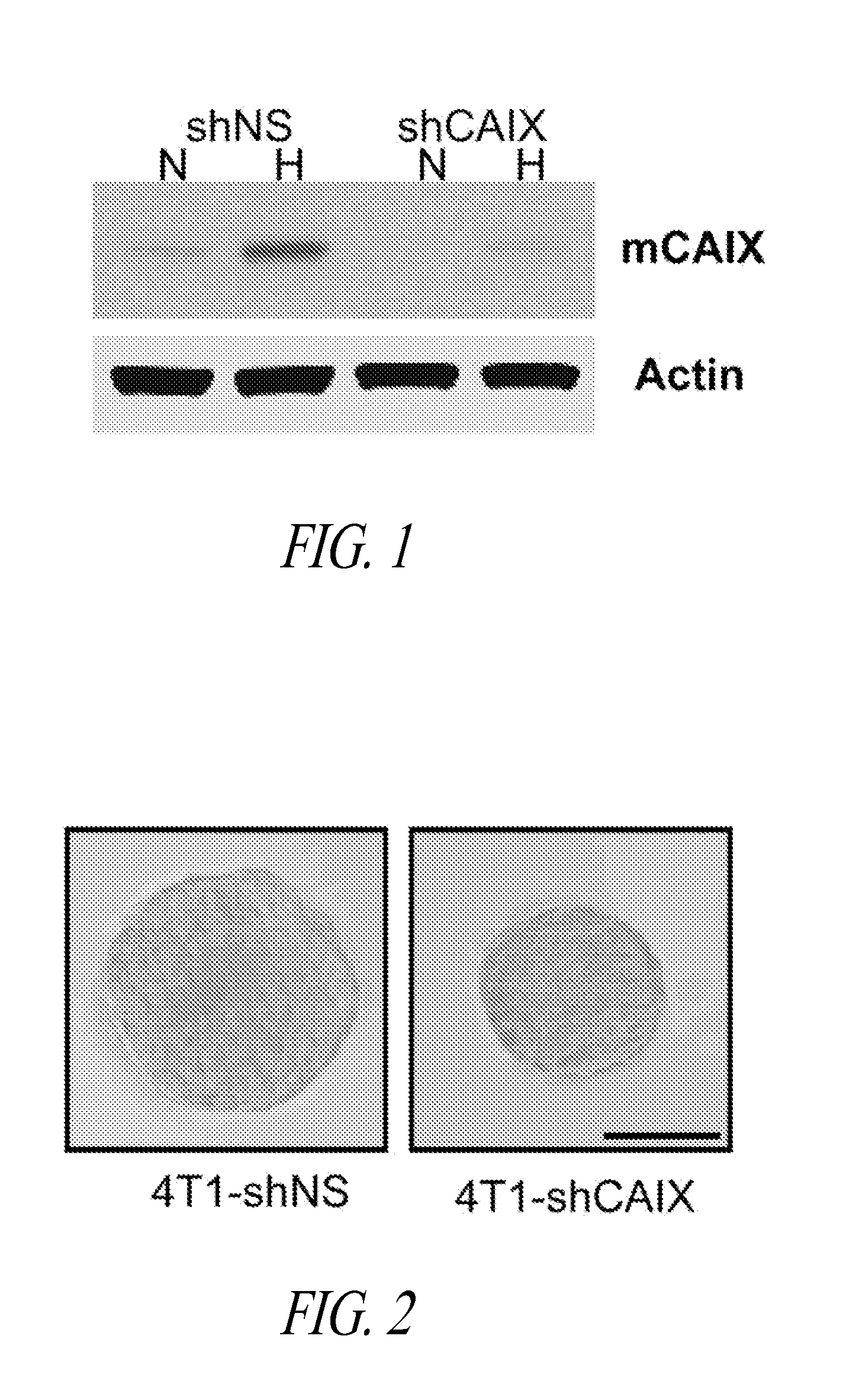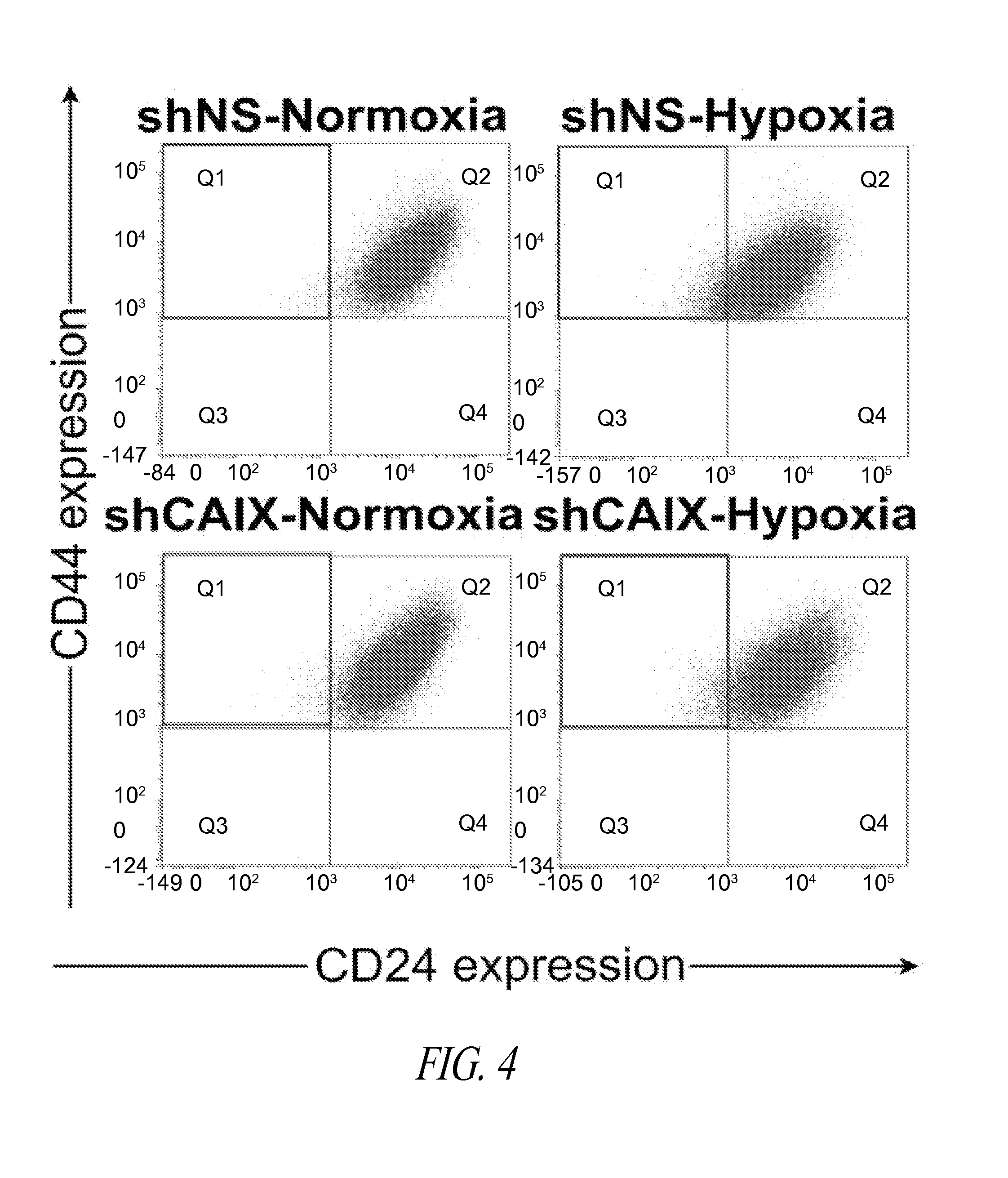Carbonic anhydrase ix-related markers and use thereof
a technology of carbonic anhydrase and related markers, applied in the field of cancer stem cell markers, can solve the problems of lack of regenerative capacity, and achieve the effect of increasing the level of epithelial markers
- Summary
- Abstract
- Description
- Claims
- Application Information
AI Technical Summary
Benefits of technology
Problems solved by technology
Method used
Image
Examples
example 1
CAIX Expression is Required for Characteristics of Breast Cancer Stem Cells
[0236]In vitro proliferation in suspension under serum free conditions as non-adherent tumorspheres has been demonstrated to be a characteristic of breast cancer stem cells (Ponti, Costa et al. 2005).
[0237]RNA interference (RNAi) was used to stably knock down CAIX expression in the 4T1 mouse breast cancer cell line (4T1-shCAIX), compared to an RNAi non-silencing control (4T1-shNS) (see FIG. 1). 4T1 cells were seeded as single cells and cultured in defined serum-free media using ultralow adherent plates as non-adherent tumorspheres (TS) (FIG. 2). These TS-forming conditions have been shown to promote cancer stem cell growth (Yip, Fombon et al. 2011, Stingl, Eaves et al. 2001, Dontu, Abdallah et al. 2003). Single cell suspensions of 4T1-shNS and 4T1-shCAIX cells were seeded at doubling dilutions and cultured under TS-forming conditions in normoxia (20% oxygen) or hypoxia (1% oxygen) for 7 days.
[0238]TS-forming ...
example 2
CAIX Inhibitors are Capable of Reducing Stem Cell Behavior in Cancer Cells
[0241]To verify these data, a well characterized CAIX small molecule inhibitor, CAI017, was used to inhibit CAIX activity in the parental 4T1 cell line (Lou, McDonald et al. 2011, Supuran 2008). Using the same experimental method described in Example 1, single cell suspensions of parental 4T1 were seeded at doubling dilutions in defined serum-free media, with CAI17 or vehicle added, and cultured as non-adherent TSs in normoxia or hypoxia for 7 days. Again, the number of parental 4T1 cells required to form TSs was significantly reduced in hypoxia, compared to normoxia controls, and inhibition of CAIX activity significantly increased the number of seeding cells required to form a TS in hypoxia, suggesting that CAIX activity alone may regulate the cancer stem cell-like population in this cell line (FIG. 6).
[0242]To confirm the “stemness” properties of the CD44+CD24− / low CSC populations quantified by FACS, TS cult...
example 3
The Mesenchymal Phenotype of Parental 4T1 CD44+CD24− / Low CSC is Observed in Normoxia and Hypdxia
[0244]Parental 4T1 cells were cultured under tumorsphere (TS) forming conditions in normoxia and hypoxia. After 7 days, TSs were collected, dissociated, and cells stained for CD44 and CD24. CD44+CD24− / low cells or a control CD44+CD24+ population were cultured for 3 days on glass coverslips in normoxia or hypoxia, then fixed and immunostained for CAIX (FIG. 9) or EMT markers (FIGS. 8, 9 and 10) (Lock, McDonald et al. 2012). Expression of CAIX was upregulated in hypoxic cultures in both CD44+CD24− / low and CD44+CD24+ control populations. No significant CAIX staining was observed in normoxic cultures (FIG. 9). Whereas significant E-cadherin expression was observed at cell boundaries in the CD44+CD24+ control populations in normoxia and hypoxia, significant loss of the expression of the epithelial marker E-cadherin was observed in CD44+CD24− / low cells in normoxia and hypoxia (FIG. 10). Further...
PUM
| Property | Measurement | Unit |
|---|---|---|
| binding affinity | aaaaa | aaaaa |
| chemotherapy resistance | aaaaa | aaaaa |
| pH | aaaaa | aaaaa |
Abstract
Description
Claims
Application Information
 Login to View More
Login to View More - R&D
- Intellectual Property
- Life Sciences
- Materials
- Tech Scout
- Unparalleled Data Quality
- Higher Quality Content
- 60% Fewer Hallucinations
Browse by: Latest US Patents, China's latest patents, Technical Efficacy Thesaurus, Application Domain, Technology Topic, Popular Technical Reports.
© 2025 PatSnap. All rights reserved.Legal|Privacy policy|Modern Slavery Act Transparency Statement|Sitemap|About US| Contact US: help@patsnap.com



